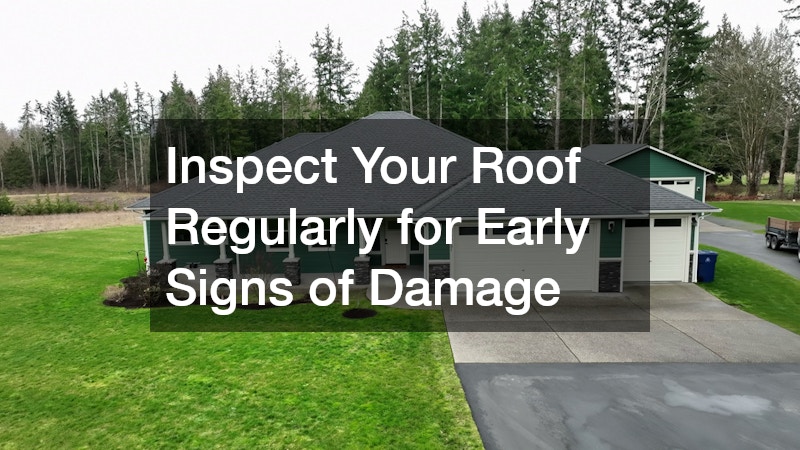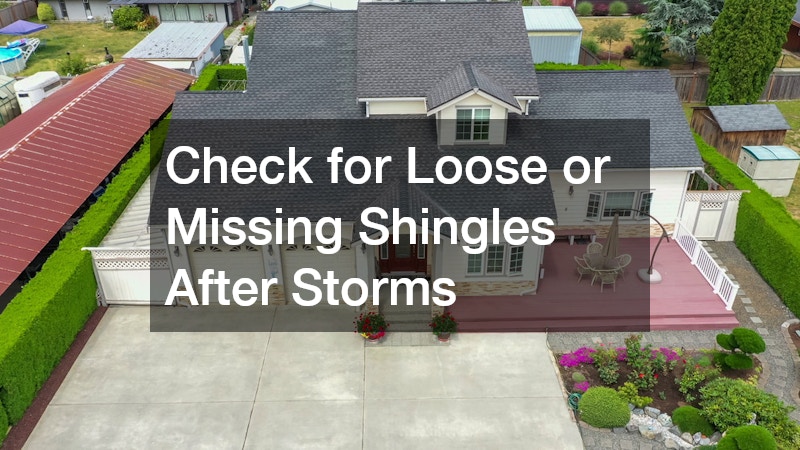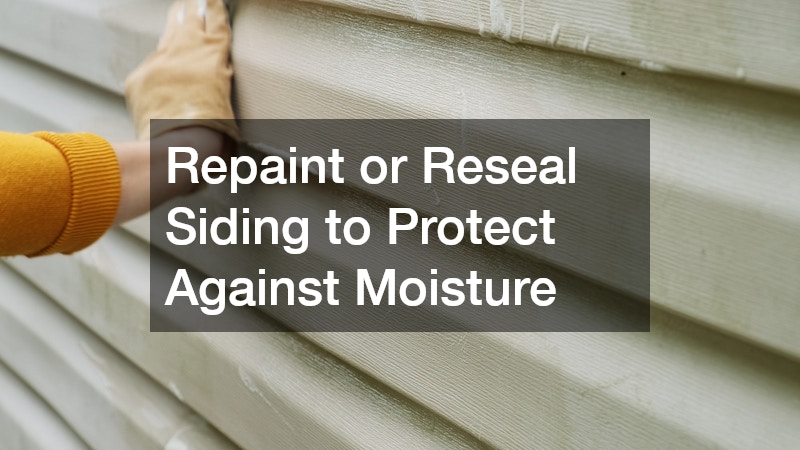Your home’s exterior is constantly exposed to the elements, making regular maintenance essential for long-term durability and appearance. Proper care of your roofing and siding not only enhances curb appeal but also prevents costly damage caused by weather, moisture, and wear. By following consistent roofing and siding maintenance routines and addressing minor issues early, you can significantly extend the life of your home’s exterior and protect your investment for years to come

Inspect Your Roof Regularly for Early Signs of Damage
Regular roof inspections and quality roofing supply are essential to maintaining the structural integrity of your home. Over time, even high-quality roofs can develop wear from weather exposure, UV rays, and debris buildup. Homeowners should inspect their roofs at least twice a year—preferably in spring and fall—to identify cracked shingles, curling edges, or areas where the surface granules are missing. Binoculars can be helpful for visual checks, but for thorough assessments, a local roofer can spot hidden problems like moisture intrusion or weakened flashing. Early detection allows you to address small issues before they become costly repairs. This proactive approach not only extends your roof’s lifespan but also ensures your home stays protected from water leaks and mold growth.
Keep Gutters and Downspouts Clean and Functional
Clogged gutters and downspouts are among the most common yet overlooked causes of exterior damage. When gutters fill with leaves, twigs, or debris, water can overflow and seep into your siding or foundation, leading to rot, mildew, and even structural instability. Local siding contractors can clean your gutters at least twice a year—or more frequently if trees are nearby. Use a ladder, gloves, and a small scoop to remove debris, then flush the system with a garden hose to ensure smooth water flow. Check that downspouts direct water at least three to four feet away from your home’s foundation to prevent pooling. Consider installing gutter guards to reduce buildup and minimize maintenance time. Regular cleaning not only protects your siding and roofline but also prevents costly erosion and basement flooding, keeping your home’s exterior in excellent condition year-round as part of your roofing and siding maintenance.
Trim Overhanging Branches to Prevent Roof Damage
Trees add beauty and shade to your property, but overhanging branches can pose serious risks to your roof and siding. Branches that brush against shingles can strip away protective granules, while falling limbs during storms can puncture the roof or damage gutters. Regularly trim back branches that come within six to ten feet of your home. This not only minimizes debris buildup from leaves and twigs but also discourages animals like squirrels from accessing your roof. When trimming, ensure cuts are clean and made at the correct junction to avoid harming the tree. For large or high branches, hiring a professional arborist is the safest choice. Keeping vegetation well-managed improves air circulation around your roof, helps prevent moisture retention, and reduces the likelihood of moss or algae growth—all key factors in extending the life of your exterior.

Check for Loose or Missing Shingles After Storms
Severe weather can wreak havoc on roofing materials, loosening shingles or tearing them away completely. After heavy winds, hail, or snow, hire roofing companies to inspect your roof for missing, cracked, or curling shingles. Damaged areas can expose your underlayment to rainwater, leading to leaks and structural deterioration. If you spot any issues, replace the affected shingles immediately to prevent moisture from penetrating deeper layers of your roof. Pay close attention to ridge caps and roof valleys, as these areas often take the brunt of storm impact. For multi-story homes or steep roofs, consider hiring a roofing contractor to perform a detailed inspection safely. Timely repairs and roofing and siding maintenance ensure your home’s insulation and attic remain dry, protecting your investment from long-term water damage, mold growth, and energy inefficiency. Routine post-storm maintenance is a simple yet effective way to safeguard your roof’s longevity.
Wash Your Siding to Remove Dirt, Mold, and Mildew
Siding accumulates dirt, pollen, and organic growth over time, especially in damp or shaded areas. Regular washing restores your home’s curb appeal and prevents long-term staining or decay. Use a garden hose with a soft brush or a pressure washer on a low setting to remove grime effectively. Be cautious not to damage the siding or force water behind panels, which could lead to rot. For vinyl or fiber cement siding, mild detergent mixed with water works well. If you notice mold or mildew, apply a solution of water and white vinegar or use a cleaner specifically designed for siding materials. Rinsing thoroughly prevents residue buildup that can attract more dirt. Routine cleaning—ideally once or twice a year—not only keeps your exterior looking vibrant but also prolongs the life of the materials, ensuring your home remains strong and beautiful.
Repair Cracks and Gaps in Siding Promptly
Cracks, warping, or gaps in siding may seem minor, but they can quickly escalate into significant issues if left untreated. These openings allow moisture, insects, and drafts to infiltrate your walls, leading to rot and energy loss. Inspect your siding regularly for visible damage, especially after harsh weather. Use high-quality exterior caulk to seal small cracks and joints, ensuring a watertight seal. For larger holes or warped panels, replacement may be necessary to maintain the integrity of your home’s envelope. Wooden siding should be repainted or resealed periodically to prevent splitting, while vinyl siding requires inspection for brittleness due to temperature changes. By addressing these problems early, you can avoid costly structural repairs and maintain your home’s appearance and energy efficiency for years to come.

Repaint or Reseal Siding to Protect Against Moisture
Your siding’s finish is its first line of defense against water, UV rays, and temperature extremes. Over time, paint or sealant can fade, peel, or crack, leaving the material exposed to the elements. As part of your roofing and siding maintenance, repainting or resealing every five to seven years (depending on material and climate) preserves both aesthetics and durability. Begin by cleaning the surface thoroughly and scraping off any loose paint. Use a primer suited to your siding type before applying two coats of exterior-grade paint or sealant. For wood siding, a stain or sealant that penetrates the grain provides excellent protection. Vinyl siding can benefit from paint specifically designed for plastics. Regular upkeep by a local painting contractor not only enhances curb appeal but also prevents warping, swelling, and decay caused by prolonged moisture exposure, ultimately extending your siding’s lifespan and maintaining your home’s market value.
Ensure Proper Ventilation in Attics and Roof Spaces
A well-ventilated attic is crucial in roofing and siding maintenance, as it helps with preventing moisture buildup and temperature extremes that can damage your roof and siding. Without adequate airflow, trapped heat and humidity can cause shingles to deteriorate prematurely and wood to rot. Proper ventilation allows hot air to escape in summer and helps reduce condensation in winter. Check that soffit vents, ridge vents, or gable vents are clear of insulation and debris. Installing a balanced ventilation system can also improve energy efficiency by reducing the strain on your HVAC system. When combined with proper attic insulation, ventilation keeps your roof cooler and prolongs its structural integrity. Regularly monitoring airflow prevents mold growth, ice dams, and high humidity levels—all of which can compromise your home’s exterior and lead to costly repairs down the line.
Address Roof Leaks Immediately to Prevent Structural Issues
Even a small roof leak can cause significant structural damage if ignored. Water intrusion leads to stained ceilings, weakened rafters, mold growth, and even compromised foundations. At the first sign of a leak—such as damp insulation, discolored drywall, or musty odors—act quickly to locate and fix the source. Common culprits include damaged shingles, faulty flashing, or clogged gutters. Temporary patching can help minimize damage, but repairs by a local roofing company ensures a long-term solution. After fixing the leak, dry any affected areas thoroughly to prevent rot or mildew. Regular inspections and immediate response to leaks protect not only your roofing system but also your home’s overall stability. Proactive roofing and siding maintenance saves you from expensive restoration work and preserves the integrity of your entire exterior structure.

Inspect Flashing and Sealants Around Chimneys and Vents
Flashing and sealants serve as critical barriers that prevent water from entering through joints and seams on your roof. Over time, exposure to heat, cold, and moisture can cause them to deteriorate, crack, or pull away from surfaces. Inspect flashing around chimneys, skylights, and vent pipes annually for gaps or corrosion. Reseal or replace damaged areas promptly to maintain waterproofing. Use high-quality roofing sealant for minor repairs or hire a contractor for more extensive replacements. Alongside professional siding installation, properly installed and maintained flashing directs water safely off the roof, preventing leaks and structural decay. Keeping these small but vital components in good shape extends your roof’s lifespan, preserves insulation, and prevents costly moisture damage to your interior and exterior walls.
Schedule Professional Roof and Siding Inspections Annually
While DIY inspections are valuable, professional assessments provide deeper insights into the condition of your roof and siding. Experts have the training and tools to identify hidden issues such as weak flashing, soft spots, or small leaks invisible to the untrained eye. Schedule an annual inspection—ideally in the spring or fall—to catch potential problems early. A professional roofing company can also evaluate whether your materials are nearing the end of their lifespan and recommend preventive maintenance or replacements. Their detailed reports often include photos, condition summaries, and repair recommendations, allowing you to make informed decisions about your home’s upkeep. Routine professional inspections not only extend the life of your exterior but also enhance safety and protect your investment from unexpected repair costs.
Invest in Preventative Maintenance to Save on Costly Repairs
Preventative roofing and siding maintenance is the most effective way to extend the life of your roof and siding while minimizing long-term expenses. Small, consistent actions—like cleaning gutters, sealing cracks, and inspecting for damage—can prevent problems from escalating into major repairs. Developing a seasonal roofing and siding maintenance checklist ensures nothing gets overlooked. Preventative care also helps retain your home’s energy efficiency, keeping heating and cooling costs under control. Hiring a professional roofing and siding contractor for periodic upkeep gives you peace of mind and preserves your property’s structural health. Ultimately, maintaining your home’s exterior is an investment that pays off by safeguarding its value and reducing repair costs.

Protect Your Roof and Siding from Moss and Algae Growth
Moss and algae may seem like harmless greenery, but they can cause serious damage to your roof and siding if left unchecked. Moss tends to trap moisture, leading to rot, shingle lifting, and premature material decay. Algae, meanwhile, leaves behind dark streaks that diminish curb appeal and may weaken roofing materials over time. To prevent growth, keep your roof and surrounding areas clear of debris and maintain adequate sunlight exposure by trimming trees. Installing zinc or copper strips along your roof ridge can help inhibit future moss buildup. For siding, use a mild cleaning solution or a specialized algaecide to gently remove stains without damaging the surface. Avoid pressure washing on high settings, as this can dislodge shingles or crack siding panels. Regular cleaning and roofing and siding maintenance treatments protect your exterior from moisture-related deterioration, especially with the help of local siding contractors.
Monitor and Maintain Your Home’s Drainage System
A well-functioning drainage system plays a crucial role in preserving your roof, siding, and foundation. Poor drainage can cause water to pool around your home, leading to foundation cracks, basement leaks, and exterior wall damage. Inspect your yard’s grading to ensure water flows away from the structure, and add soil where necessary to maintain a gentle slope. Check that gutters, downspouts, and splash blocks direct water several feet from the base of your home. If you have a French drain or sump pump, keep it clean and test it regularly for efficiency. Installing downspout extensions or rain barrels can also help manage runoff effectively.
Maintaining your roof and siding is one of the most effective ways to preserve your home’s strength and beauty. From regular inspections to preventative cleaning and timely repairs, every effort helps safeguard your property from environmental damage. A proactive roofing and siding maintenance plan not only saves you money on future repairs but also ensures your home remains comfortable, energy-efficient, and visually appealing for decades to come.
